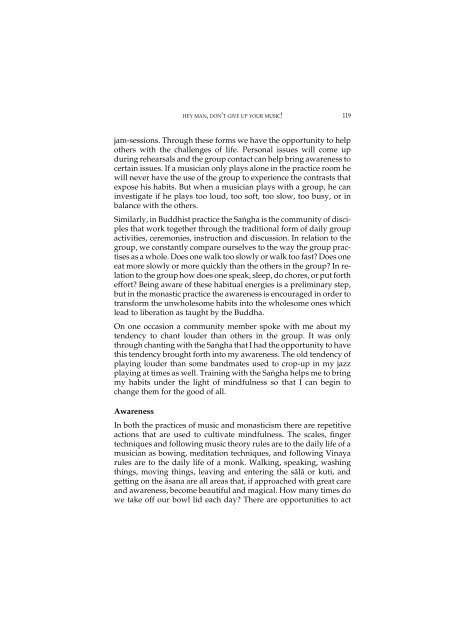Forest Path - Amaravati Buddhist Monastery
Forest Path - Amaravati Buddhist Monastery
Forest Path - Amaravati Buddhist Monastery
You also want an ePaper? Increase the reach of your titles
YUMPU automatically turns print PDFs into web optimized ePapers that Google loves.
hey man, don’t give up your music! 119<br />
jam-sessions. Through these forms we have the opportunity to help<br />
others with the challenges of life. Personal issues will come up<br />
during rehearsals and the group contact can help bring awareness to<br />
certain issues. If a musician only plays alone in the practice room he<br />
will never have the use of the group to experience the contrasts that<br />
expose his habits. But when a musician plays with a group, he can<br />
investigate if he plays too loud, too soft, too slow, too busy, or in<br />
balance with the others.<br />
Similarly, in <strong>Buddhist</strong> practice the Saïgha is the community of disciples<br />
that work together through the traditional form of daily group<br />
activities, ceremonies, instruction and discussion. In relation to the<br />
group, we constantly compare ourselves to the way the group practises<br />
as a whole. Does one walk too slowly or walk too fast? Does one<br />
eat more slowly or more quickly than the others in the group? In relation<br />
to the group how does one speak, sleep, do chores, or put forth<br />
effort? Being aware of these habitual energies is a preliminary step,<br />
but in the monastic practice the awareness is encouraged in order to<br />
transform the unwholesome habits into the wholesome ones which<br />
lead to liberation as taught by the Buddha.<br />
On one occasion a community member spoke with me about my<br />
tendency to chant louder than others in the group. It was only<br />
through chanting with the Saïgha that I had the opportunity to have<br />
this tendency brought forth into my awareness. The old tendency of<br />
playing louder than some bandmates used to crop-up in my jazz<br />
playing at times as well. Training with the Saïgha helps me to bring<br />
my habits under the light of mindfulness so that I can begin to<br />
change them for the good of all.<br />
Awareness<br />
In both the practices of music and monasticism there are repetitive<br />
actions that are used to cultivate mindfulness. The scales, finger<br />
techniques and following music theory rules are to the daily life of a<br />
musician as bowing, meditation techniques, and following Vinaya<br />
rules are to the daily life of a monk. Walking, speaking, washing<br />
things, moving things, leaving and entering the sàlà or kuti, and<br />
getting on the àsana are all areas that, if approached with great care<br />
and awareness, become beautiful and magical. How many times do<br />
we take off our bowl lid each day? There are opportunities to act

















